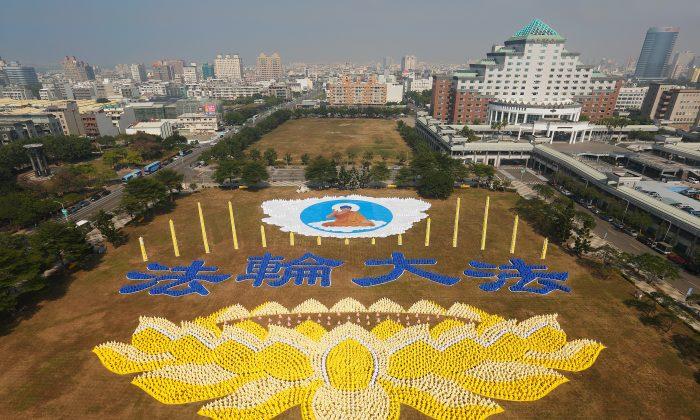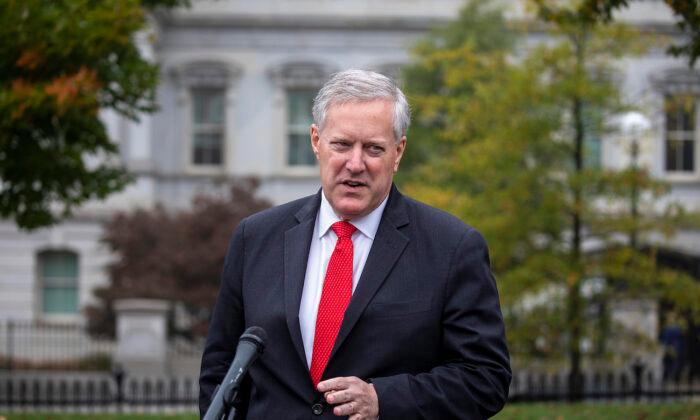While sabers were rattling in Tokyo and Beijing in response to China’s claim to an air defense zone that encompasses most of the East China Sea, around 7,000 practitioners of Falun Dafa assembled in Kaohsiung, Taiwan, on Nov. 24 to form an image of peace and benevolence.
The practitioners of Falun Dafa, also known as Falun Gong, had come from far-off destinations, such as the United States, Canada, Switzerland, and Peru, as well as from relatively nearby locations such as Hong Kong, South Korea, Japan, and Vietnam, and, of course, Taiwan for the Taiwan Falun Dafa Association annual conference. This year’s conference was the largest to take place in Taiwan in the 18 years since Falun Dafa was first introduced to Taiwan.
Adherents of Falun Gong practice a set of meditative exercises and strive to become better persons by living according to the principles of truthfulness, compassion, and tolerance. At conferences, practitioners give short talks reporting on the challenges and the discoveries they have made as they cultivate (seek to improve themselves) according to the practice’s teachings.
A large conference like the one in Taiwan is typically the centerpiece of a lively weekend full of events that may include musical performances, a parade, large demonstrations of the Falun Dafa exercises, displays telling the public about Falun Dafa and how it is persecuted in China, film screenings, talks, assembling to form an image, and other activities.
Order and Precision
The practitioners gathered on Sunday in a park opposite the Tainan government buildings to form the image (Tainan is a city next to Kaohsiung, the site of the Falun Dafa conference). As with the images formed by marching bands, what is shown may be fully seen only from above.
The display is a work of art that depends on order and precision for its execution. Individuals line up in very precise positions. By wearing clothes of different colors, together the whole body of practitioners forms a picture.
Tainan City Councilor Li Wen-cheng said he was very moved by the solemn presentation of the Falun Gong practitioners.
According to the image’s technical designer, Mr. Wu Ching-Hsiang, the design was meant to convey the popularity of the practice.
The image showed a lotus flower, with four Chinese characters above that, and a figure meditating above the characters.
The lotus flower grows in the mud and then, extending upward, yields a beautiful flower. In traditional Chinese thought, the flower is taken as a symbol for spiritual cultivation.
The four characters spell out the words “Falun Dafa is widely spread and the Buddha light will shine.” Traditionally, Buddha light is said to be the energy emitted by an enlightened being. It is believed to have beneficent and healing qualities. Falun Dafa has spread from China to 114 countries and areas throughout six continents.
Countering Persecution
“A good belief is helpful and essential to overall health and it is inconceivable that it [Falun Dafa] is persecuted in mainland China,” said Tainan City Councilor Li Wen-cheng.
“Every Taiwanese in every corner of Taiwan should show their concern for Falun Gong. The Chinese Communist Party (CCP) must stop their persecution of Falun Gong, otherwise they would be condemned by the whole world and from the heavens,” he said.
In 1999 the then-head of the Chinese Communist Party, Jiang Zemin, launched a campaign to eradicate the practice of Falun Dafa. Jiang feared how popular the practice had become. Chinese government estimates reported at least 70 million people were practicing Falun Dafa, and Falun Dafa practitioners said 100 million people had taken up the practice—more than were members of the Chinese Communist Party.
Jiang also feared the popularity of Falun Dafa’s traditional moral teachings. He thought that as Falun Dafa spread in China, the ideology of the CCP would lose its hold on people.
Speaking at the event, Taiwanese human right lawyer Ms. Theresa Chu said that forming the image conveyed a powerful message of calm amid the current chaos, and also reminded people of the persecution in China.
“Besides that, the scale of the peaceful activity of collective character formation also shows that the laws in Taiwan protect the rights of Falun Dafa practitioners as well as those of the general public to the practice of their faith, and their exercise of free speech and assembly,” Chu said.
Chu also said that a lot of people were drawn to begin practicing Falun Dafa after seeing the beautiful, orderly character formation at past events.
“They were so impressed, they started to cultivate, and this changed their lives,” she said.
“Taiwan practitioners were also grateful to the founder of Falun Gong, Mr. Li Hongzhi, for his great efforts in spreading Falun Dafa,” she said.
Canadian international human rights lawyer David Matas, a 2010 Nobel peace prize nominee, visited Taiwan on Nov. 22 to give a talk about the crime of organ harvesting by the CCP.
According to investigations done by Matas with David Kilgour, a former Canadian secretary of state, since the persecution began, the CCP has used detained Falun Dafa practitioners as a living organ bank. Thousands of practitioners are killed every year for their organs, they say.
Dr. Hu Nai-Wen, chairman of the Taiwan International Organs Transplant Caring Association, said the weekend’s conference would help in ending the persecution of Falun Dafa, and with it the atrocity of forced organ harvesting.
Through the two days of activities, including coming together to form an image, people see that Falun Gong is prospering in all parts of the world, he said. Such activities debunk the CCP’s propaganda that slanders Falun Dafa, he said.
(Youtube by Derrick Wu)





Friends Read Free